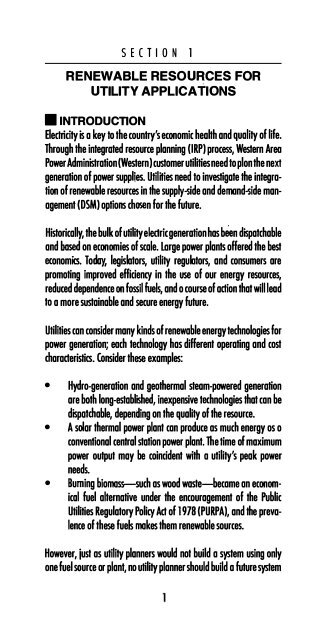DSM Pocket Guidebook Volume 5: Renewable and Related ... - NREL
DSM Pocket Guidebook Volume 5: Renewable and Related ... - NREL
DSM Pocket Guidebook Volume 5: Renewable and Related ... - NREL
Create successful ePaper yourself
Turn your PDF publications into a flip-book with our unique Google optimized e-Paper software.
SECT I O N 1<br />
RENEWABLE RESOURCES FOR<br />
UTILITY APPLICATIONS<br />
.INTRODUCTION<br />
Electricity is o key to the country's economic health <strong>and</strong> quality of life.<br />
Through the integrated resource planning (IRP) process, Western Areo<br />
Power Administration (Western) customer utilities need to pion the next<br />
generation of power supplies. Utilities need to investigate the integration<br />
of renewable resources in the suppide <strong>and</strong> demondide management<br />
(<strong>DSM</strong>) options chosen for the future.<br />
Historically, the bulk of utility electric generation has been dispatchoble<br />
<strong>and</strong> bused on economies of scale. Lorge power plants offered the best<br />
economics. Today, legislators, utility regulators, <strong>and</strong> consumers ore<br />
promoting improved efficiency in the use of our energy resources,<br />
reduced dependence on fossil fuels, <strong>and</strong> o course of action that willleod<br />
to o more sustainable <strong>and</strong> secure energy future.<br />
Utilities con consider many kinds of renewable energy technologies for<br />
power generation; eoch technology has different operating <strong>and</strong> cost<br />
chorocteristics. Consider these examples:<br />
• Hydro-generation <strong>and</strong> geothermal steam-powered generation<br />
ore both long-established, inexpensive technologies that con be<br />
dispatchoble, depending on the quality of the resource.<br />
• A solar thermal power plant con produce os much energy os o<br />
conventional central station power plant. The time of maximum<br />
power output may be coincident with o utility's peak power<br />
needs.<br />
• Burning biomass-such os wood waste-become on economical<br />
fuel alternative under the encouragement of the Public<br />
Utilities Regulatory Policy Act of 1978 (PURPA), <strong>and</strong> the prevalence<br />
of these fuek makes them renewable sources.<br />
However, just os utility planners would not build o system using only<br />
one fuel source or plant, no utility planner should build o future system
















